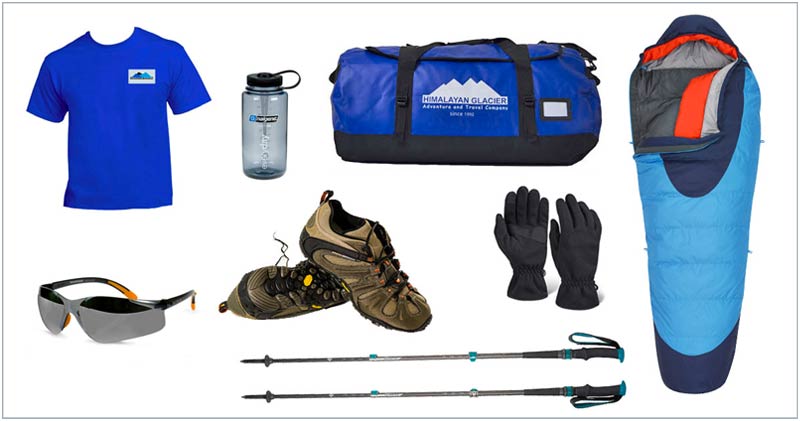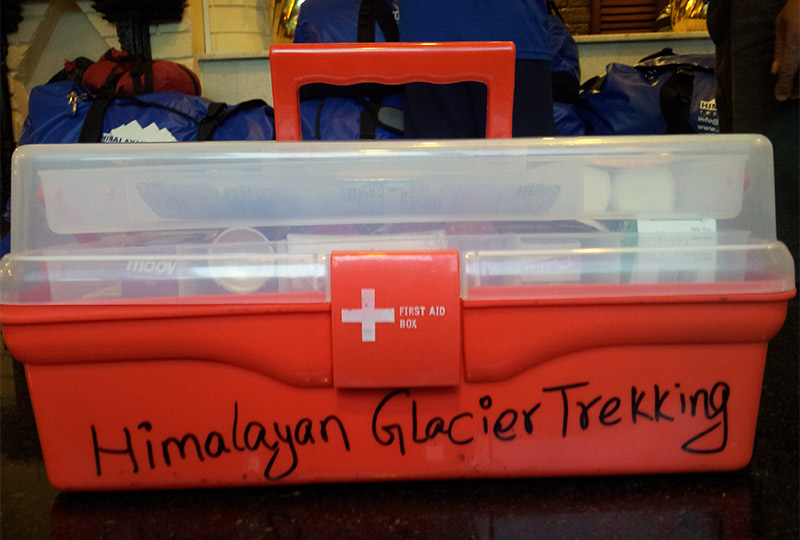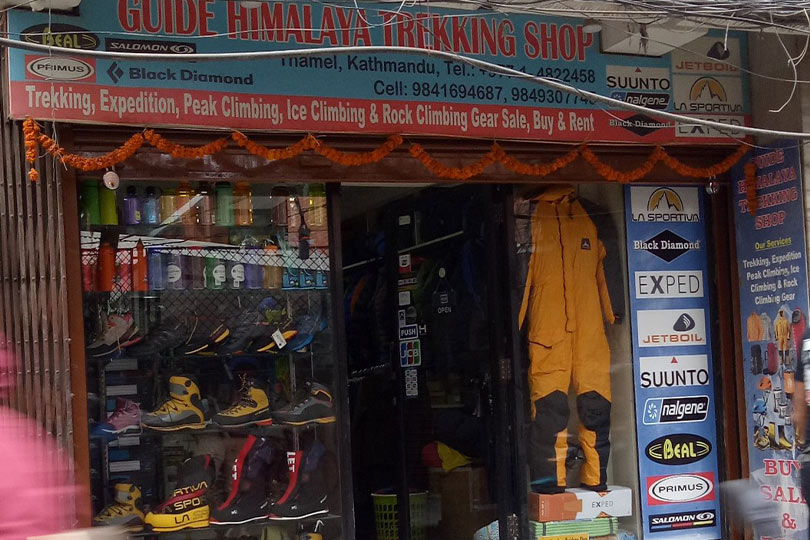The Kailash Mansarovar Yatra is a sacred pilgrimage for Hindus around the world. They consider it to be the ultimate destination of souls and the spiritual heart of the world. According to Hinduism, Mount Kailash is the home of Lord Shiva, where he meditated with his wife Parvati, the daughter of the Himalayas. Lake Mansarovar, located at the base of Mount Kailash, is regarded as the purest water on earth. Bathing in it is said to wash away sins from a hundred lifetimes.

The undertaking of the Kailash Mansarovar Yatra requires careful preparation and planning, and packing plays a crucial role in ensuring a safe and comfortable journey. To help with this, we have prepared a comprehensive packing list for Kailash Mansarovar Yatra that covers all the essentials, from headwear to footwear and personal items that are necessary during your Yatra.
Packing list for kailash mansarovar yatra
1. Travel Documents
- Passport size photos – 2 copies
Keep photos and passport in a small zip bag to protect from rain
2. Travel Clothing

a. Headwear
- Winter hats with ear covers – 2 piece
They protect your head and ears from the cold and wind. They also help you retain body heat and avoid hypothermia during the freezing cold night at Kailash. - Headlamp with extra batteries
It allows you to see in the dark and keep your hands free to navigate safely and comfortably. Don’t forget to bring extra batteries as you may not have access to electricity or charging facilities during the trip. - UV protective Sunglasses with retainer (Thread/chain)
It is one of the vital things to carry for Kailash Mansarovar Yatra as it shields your eyes from the harmful ultraviolet rays of the sun. UV protective sunglasses will also reduce glare and improve your visibility.
b. Handwear
- Hand Gloves – 2 pairs (One warm and soft , one water resistant/Ski Gloves)
They keep your hands warm and comfortable. One pair should be warm and soft, suitable for mild weather and daily activities. The other pair should be water-resistant or ski gloves, suitable for cold and wet weather and outdoor activities.
c. Bodywear
- Long Sleeve Shirt – 2 pieces (Fleece or Hoodie)
It provides coverage and protection for your arms while also regulating your body temperature and preventing sunburn. - Short sleeve T-shirt or Polo – 1 piece
It offers versatility and comfort as you can wear it as a base layer under your long sleeve shirt or jacket, or as a standalone top when the weather is warm. - Warm Scarf – 1 piece
It wraps around your neck and provides warmth and comfort. It will help you retain heat and prevent colds and sore throats. - Shawl – 1 piece
It can serve multiple purposes and functions as you can use it as a blanket, a cover-up, a headscarf, or a wrap. - Gore-Tex – 1 pair
They are waterproof, windproof, and breathable and can keep you dry and comfortable in various weather conditions. - Windbreaker jacket – 1 piece preferably with a hoodie (water resistant/proof and oversize)
It protects you from the strong and chilly winds that can blow at high altitudes. It should preferably be water-resistant or water-repellent. - Oversized Poncho – 1 piece (lightweight and cheap ones only!)
It covers you and your backpack from the rain or snow. An oversized poncho will also provide you with some extra warmth and comfort. - Thermals – 2 pairs (two leggings and two top – microfiber thermals recommended)
They provide you with a base layer of insulation and warmth. They also wick away moisture and sweat from your skin and keep you dry and comfortable. - Pajamas – 1 set (Warm one for night’s sleep)
- Down jacket (provided or May choose to bring your own)
It provides you with a layer of warmth and protection. You can choose a down jacket that is water-resistant or water-proof, depending on your preference. - Undergarments – 5 pairs
- Pants – 5 pairs (2 YOGA pants or Joggers, 1 Cargo, 1 windproof- waterproof – breathable, 1 Ski Pants)
d. Footwear
- Extra Thick socks – 2 pairs (woolen ones are recommended)
They are essential for keeping your feet warm and comfortable during the trip. - Sock Liners – 2 pairs(for Parikrama Days)
- Regular socks – 4 pairs (to be worn up until Mansarovar and return)
- Ankle support Hiking Boots (should be 1 size bigger than your foot measure)
They are essential things to pack in Kailash Mansarovar Yatra. They are designed to provide traction, stability, and comfort on uneven and rough terrain. They provide support to your feet and ankles and prevent injuries and also reduce the risk of sprains and strains. Hiking boots should be one size bigger than your foot measure, to allow for swelling and thick socks. - Sneakers or Tennis Shoes – 1 pair
You can wear these when you are not hiking or when you want to give your feet a break from the hiking boots.
3. Trekking Equipment
- Small backpack preferably with an outside pocket to hold a water bottle. (child size only!)
- Trekking Poles – 2 pair (to be used during Parikrama)
They provide assistance with stability and balance on uneven and slippery terrain, and prevent falls and injuries during Parikrama.
4. Trekking Accessories

- Bags (4 small and large zip lock, 4 X- large garbage bags, 10 plastic grocery bags)
- Locks – for your luggage (3 Combination locks recommended)
- Digital Camera (with video capability)
- I-pod or Mp3 player, Speakers
- A water bottle (should hold up to 30 oz)
- A hot water bottle (to drink water at night time (should hold up to 24-30oz))
- Hand warmers and foot warmers – each 8 pairs (totaling = 16 pairs (32 individual packets) )
- Umbrella
5. First Aid & Medicines

- Antibiotics
We recommend you carry two courses of antibiotics as prescribed by your physician, one for chest & respiratory tract infections, and the other for abdominal or bowel infections.
Please don’t bring sleeping pills as they are respiratory depressants. - Painkillers
We recommend that you carry Paracetamol, Aspirin, Ibuprofen, Tylenol, or Advil to shoo away your headaches or body aches. - Cough Lozenges
Carry some cough lozenges or throat pastilles used for treating cough caused by minor viral upper respiratory tract infections or for the inevitable dry throat at high altitudes. - Plasters, Bandages & Zinc Oxide Tape
They are useful for any cracked skin or small cuts. - Foot Powder
They help you get rid of the bad odor coming out from your sweaty feet while also inhibiting bacterial growth. - Skin-blister repair kit
They help prevent and manage blisters and calluses while walking long hours during the Yatra. - Antidiarrheals
Common anti-diarrhea pills, such as Imodium or Lomotil that help stop or slow diarrhea are recommended to carry. - Altitude sickness drugs
Diamox or Acetazolamide to prevent AMS. You should always consult your doctor for medicines.
Warning: Never take any medication without your doctor’s approval. Only use the drugs that are prescribed by your physician.
- Water purification tablets or water filters
They are essential to purify the water along the trails. As there are no facilities to recycle plastic bottles in the mountains, we do not recommend buying water on the trail. - Earplugs
These can be essential for blocking out sounds that could interfere with your sleep, like your partner’s snoring or intrusion of water, dust or excessive winds. - Prescriptions
Prescriptions provided by your doctors. - Sunscreen Cream
Due to the high risk of sunburn you should always carry a strong factor long-lasting, waterproof sun-block cream. We recommend having a Factor 50 + to protect you from the extreme rays, in particular P20, FixDerma Shadow, Rivela Lite, Minimalist, and La Shield Fisico. - Lip Balm
Lip balm preferably with SPF25 protection is recommended to protect yourself from chapped or wind-burnt lips caused by the fierce sun in high altitudes. - Insect Repellent
Although mosquitoes are not spotted at higher altitudes, we recommend carrying an effective insect repellent spray containing DEET. - Hand Sanitizer
They are generally used to kill many viruses, bacteria, or microorganisms from your hand. - Wet Wipes/Baby Wipes (recommended)
We always recommend bringing a pack of Baby Wipes to keep yourself clean in the wilderness - Snacks, lightweight, high calorie (optional)
We recommend that you bring a few of your favorite snacks that are lightweight and contain high calorie, such as chocolates, nuts, sweets, energy bars, etc. - Electrolytes, powder, or tablets (optional)
Electrolytes can prove vital to prevent dehydration during your hike.
6. Toiletries/Personal Hygiene
- Towel -1 (lightweight)
- Pillowcase and sheet
- Toothbrush (preferably biodegradable)
- Toothpaste (preferably biodegradable)
- Contact lenses or Glasses
- Soap – small bar or bottle (preferably biodegradable)
- Dry Shampoo (preferably biodegradable)
- Quick-drying towel (medium-sized)
- Deodorants
- Nail Brush & Clippers
- Small hair brush
- Face flannel
- Hand sanitizer
- Moisturizing cream ( for hand and face)
- Face wipes
- Lip balm
- Toilet paper
- Eye drops
- Oral rehydration sachets
- Flasks
Buying or Renting Gears?
If you’re planning a trip to Kailash Mansarovar Yatra, then you might be wondering about the gear and equipment you need to bring with you. Fortunately, you have options whether to buy or rent them.
You can purchase them in your home country and bring them along with you. However, if you want to avoid the hassle of traveling with luggage don’t worry as you have the option to purchase them in Kathmandu. In Kathmandu, you can find plenty of shops that sell high-quality and branded gear as well as affordable and locally-made products.

On the other hand, renting gear can be a practical option if you don’t want to spend too much on equipment that you might not use often. However, there’s always a risk of getting low-quality and damaged items. Therefore, to ensure the best possible rental experience, seek help from a travel agency or guide that you’re traveling with.
How to prepare for the Kailash Mansarovar Yatra?
The Kailash Mansarovar Yatra can be a challenging but rewarding pilgrimage for Hindus. It requires careful preparation and planning. The spiritual journey to Kailash Mansarovar demands not only faith and devotion but also physical and mental readiness. Therefore, to help you prepare for this sacred adventure, here are some tips and advice that you can follow:
Exercise: It is the foremost essential part for preparing for the Kailash Mansarovar Yatra. It improves the physical fitness and endurance required for the Yatra. Once you have booked the trip, you should start to follow a daily exercise routine that includes activities such as running, walking, biking, swimming, and other similar activities.
Acclimatization: As you’ll be traveling to a higher altitude, it is essential to know about acclimatization and its importance. It helps to prevent altitude sickness and other health issues that may occur during the Yatra. You should drink plenty of water, avoid alcohol and tobacco, eat light and nutritious food, and rest well during the acclimatization days.
Hydration: It is an important practice in order to prevent dehydration and altitude sickness. You should avoid alcohol and caffeine, which can cause dehydration. Being hydrated also helps to improve blood circulation and oxygen delivery to the body, which is essential for coping with high altitude and low oxygen levels.
Nutrition: Proper nutrition is crucial to maintain the energy and health required during the journey. You should avoid spicy, oily, and heavy food, which can cause indigestion and discomfort, and eat light & nutritious foods such as fruits, vegetables, cereals, etc.
Gear & Equipment: Proper gear and equipment are essential to ensure a safe and comfortable journey. The gears and equipment should be durable to withstand wear and tear throughout the remote and challenging terrain of the Himalayas.
Altitude sickness: The high altitude of the Kailash Mansarovar Yatra can cause altitude sickness, which can affect your physical and mental well-being and hinder your spiritual experience. Therefore, it is important to be aware of the symptoms of altitude sickness and take necessary precautions, such as acclimatization and hydration, to prevent it.
Frequently Asked Questions
1. Is a visa required for the Kailash Mansarovar yatra?
Yes, Kailash Mansarovar Yatra required a valid visa as it is located in the Tibetan Autonomous Region of China. In addition to a visa, you also need a passport that is valid for at least six months. If you plan to go on a pilgrimage tour to the holy Mt. Kailash and Lake Mansarovar, Himalayan Glacier can assist you with the permit and visa requirement for Kailash yatra.
2. How to get a visa for Kailash Mansarovar?
All foreign travelers are required to have a valid China visa and a Tibet Travel Permit to enter Tibet. Visitors traveling to Tibet from Nepal should apply for a group tourist visa through the Chinese Embassy in Kathmandu. Himalayan Glacier will make necessary arrangements for your Chinese visa as well as Tibet Travel Permit when you book your Kailash Mansarovar trip with us. You can simply message us in Facebook or WhatsApp us at +1-410-307-0007.
3. How can I go to Kailash Mansarovar from India?
There are two routes to reach Kailash Mansarovar from India. The first route is via Sikkim, where it goes through Nathu La Pass. This route is suitable for the elderly who are unable to undertake trekking since it is motorable. The other route is via Lipulekh Pass, which is located in Uttarakhand. This route requires some trekking and is perfect for those looking for adventure.
4. How much does it cost to go to Kailash?
Generally, for Indian nationals, the price could range anywhere between $2000 to $4000 while for non-Indian nationals the price ranges between $3000 and $5000. There are various factors that will affect the price of a Kailash Mansarovar trip, namely the route you travel, the number of people in a group, traveling season, means of transportation, the standard of hotel and dining, and other aspects
5. What is the best time to visit Kailash Mansarovar?
Kailash Mansarovar can be visited any time during the months from mid-April to September end of each year. However, the best time to arrange your travel to Mt. Kailash is undoubtedly April to June and September which offers high visibility of the mountain along with the stunningly beautiful views and the wonderful temperatures. July and August are the monsoon months that bring intermittent light rains and fog. November through March is the cold season that experiences ice and heavy snowfalls making it nearly hard to cross certain sections of the trail.






